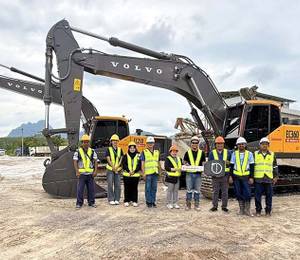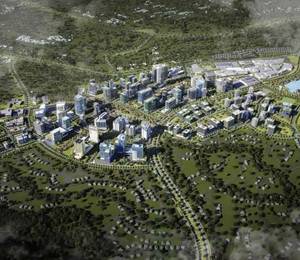With more than 30 years’ experience under her belt, Alice Chow is now a fellow and director of advisory services in East Asia at Arup. Based in Hong Kong, she has managed a range of award-winning projects designed for various purposes, such as education, healthcare, tech and industrial, and transport facilities. The most notable ones include Hong Kong’s airport as gateway to the world, HSBC data centre which broke new ground for the data centre industry in Hong Kong, and the city’s largest hospital developments to cope with the growing and ageing population.
“I’ve always been interested to build something useful for people and for the society,” Alice says.
“I remember when I was a kid, I promised my mother that I would build a house for her when I grew up. It was only later that I realised rising up a real building would need much more than technical know-how!”
After graduating with a civil engineering degree, Alice started her career as a structural engineer working on high-rise buildings, and later had the opportunities to take on a project management role, leading some of the most complex projects in Asia. “I am keen to combine my engineering expertise with commercial insight to ensure the successful delivery of projects.”
Championing of digital transformation
In the past decade, with the period of digital transformation accelerating quickly, Alice has a clear vision and is committed to lead the construction industry into new dimensions.
“Some of the key trends I find very exciting are the huge potential of big data in engineering application and digital automation,” she explains.
“Big data provides opportunities that simply didn’t exist before digital – it’s a fundamental element to generate new insights, designs and our ability to break new ground in the built environment.
“At Arup, we’ve been developing innovative ways to capture data and enable further analysis and monitoring to generate valuable insights and actionable items to enhance operation and maintenance of projects. For example, we’ve been helping our bridge clients by embedding real time sensors, for the Stonecutters bridge in Hong Kong and Queensferry Crossing in Scotland, that can power autonomous operational systems.”
Alice points out that by adopting digital automation, processes that took months in the past can now be completed in just days or even hours. “Digital automation tools have been widely adopted in our everyday work. From design to operation, we are capitalising on various key technologies on different projects that help us remove repetitive processes, increase accuracy and efficiency, leaving us more time to solve complex, challenging problems and develop quality and innovative solutions for clients.
“Digital tools also help us deliver sustainable outcomes by optimising assets across their lifetime, by modelling new pathways to net zero, and by supporting better ways to plan and manage whole cities.”
‘Important to retain experienced female engineers’
After three decades of being an engineer, Alice still finds her role “exciting and fascinating” and she keeps her ambition alive. “I’m proud to be able to contribute my expertise to enhance people’s lives with a better built environment.”
Her journey, however, has been one full of challenges, as she began her career at the time when the construction industry was largely regarded as ‘a man’s world’.
“It wasn’t easy to get a job in the first place, and often people didn’t take my profession as an engineer seriously. I had to make much more efforts to demonstrate my capabilities to excel in the profession.
“As most of my colleagues were men, some of the settings and facilities provision at the workplace - such as sanitary facilities at construction sites - were not female-friendly.”
Superstition was also widespread, adding to the challenges. “Tunnelling was one aspect of the industry that was most opposed to the involvement of women – females were not allowed to go into a tunnel during construction, which was believed to bring bad luck.”
But things are changing, and Alice has witnessed the progress of women in the construction industry over the years. “I see more females joining the industry – still at a lower ratio, but it’s certainly on an increasing trend.
“When I was studying civil engineering in university, only two female students graduated from my class of about 60 students; whereas in the recent job applications we received, 30% of the applicants were females. Also, my team has maintained 50:50 in gender ratio for many years.”
Alice deeply believes that “it is also important to retain experienced female engineers, who may face difficulties at different life stages due to their family roles. Employers are trying to accommodate their needs while enabling them to continue to contribute.
“At Arup, we have a flexible working arrangement for colleagues to accommodate their personal or family needs, while staying in the industry and keeping abreast of the development. I fully support initiatives like this, which enables women to better plan and manage their family and professional progression.”
Embracing diversity
Alice mentions that in recent years, more companies have started to appreciate the importance of diversity in strengthening their business. “We need a more diverse and dynamic work environment,” she states.
“Embracing diversity – not just gender diversity but inclusion of people from different cultures, ages, ethnicities, religions, etc. – opens the door for creativity and innovation. Males and females often have different focuses and perspectives, and they can complement each other to achieve a more desirable outcome that may not be attainable without each other.”
She further explains that, today, engineering is more than analytical and technical capabilities. “It is also about creating social value, engaging the public and ensuring a project’s lifecycle sustainability. Women are often more empathetic, observant and better listeners. These skills can help the team better understand the needs of the client and society, creating a more inclusive built environment for all.”
On her final note, Alice emphasises that despite its dynamic nature, engineering profession “can be quite demanding in terms of physicality and workload. Women who are interested to join the industry should prepare themselves to handle tough jobs. They may also need to balance their family roles and professional development, for example, switching to part-time working when they have children.
“Last but not least, be your own best advocate and show people what you can do and contribute at work!”
Photos courtesy of Arup (second photo © Paul Carstairs)













